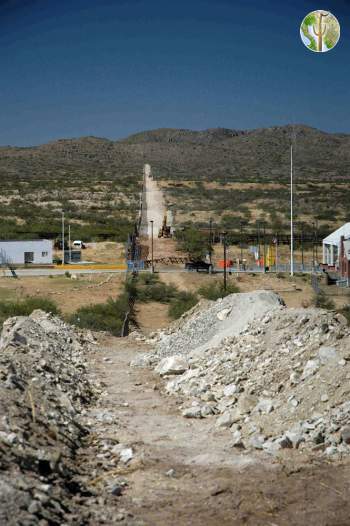The Borderlands: Walls, People, and Wildlife
 The northern border region of Sonora is almost entirely remote country. Historically it has been used by Mexicans and Tohono O'odham primarily as ranch land, which is relatively unprofitable. But this area has much economic potential solely because the U.S./Mexican border crosses it. Locals and others take advantage of the illegal drug trade and migrant smuggling industries, which have proliferated from increased law enforcement and demand from U.S. drug consumers.
The northern border region of Sonora is almost entirely remote country. Historically it has been used by Mexicans and Tohono O'odham primarily as ranch land, which is relatively unprofitable. But this area has much economic potential solely because the U.S./Mexican border crosses it. Locals and others take advantage of the illegal drug trade and migrant smuggling industries, which have proliferated from increased law enforcement and demand from U.S. drug consumers.
For decades these activities were primarily carried out in urban areas (and to some degree still are), but in the last couple of decades the U.S. Border Patrol has systematically worked to push activity into remote and wild parts of the borderlands, ignorantly thinking it would help them gain the upper hand. The majority of drugs still come through the ports of entry, but many migrants are pushed into attempting more remote and dangerous crossings routes. Hundreds of migrants a year die crossing the Sonora border into Arizona, most of cold or dehydration in the summer heat.
The current U.S. policy on drugs and migrants is making these economies valuable, and like prohibition, people are taking advantage of record profits this policy enables, forming powerful and organized cartels, inviting further corruption and violence.
Activities and infrastructure from U.S. border policy is wreaking havoc on ecosystems along the border. Border wall construction is quickly becoming one of the most serious threats to ecosystems in the Sonoran Desert and Sky Island regions.
The border wall severs cross-border ecosystems shared by Mexico and the U.S. Large and small animals are prevented from migrating, young from disbursing, individuals from finding new territories. The border wall's impacts to larger animals such as Jaguars, bears, or coati are obvious, but what is not are the innumerable smaller animals that are impacted. Frogs, snakes, small mammals, and even some species of birds are prevented from moving across the landscape. Activity, lights, roads and other border related disruptions are killing and causing problems for a variety of wildlife.
Climate change and species' needs to adjust and move to more suitable habitat will be especially affected by U.S./Mexico border walls. Predicting the exact effects on species is difficult, but the need for movement corridors of many species is a no-brainer.
Beyond the wall there are many other environmental impacts associated with border activities. New road construction, off-road vehicles, erosion, high-power flood-lights, and general increased activity are all taking their toll on wildlife and plant-life in the border region.
